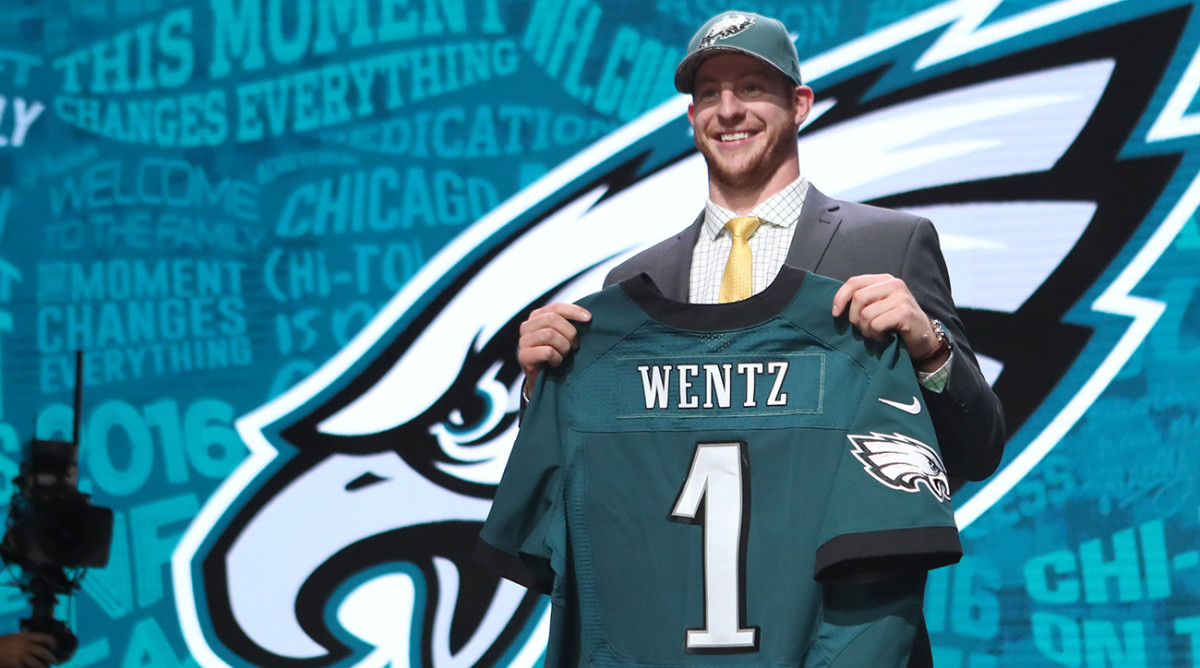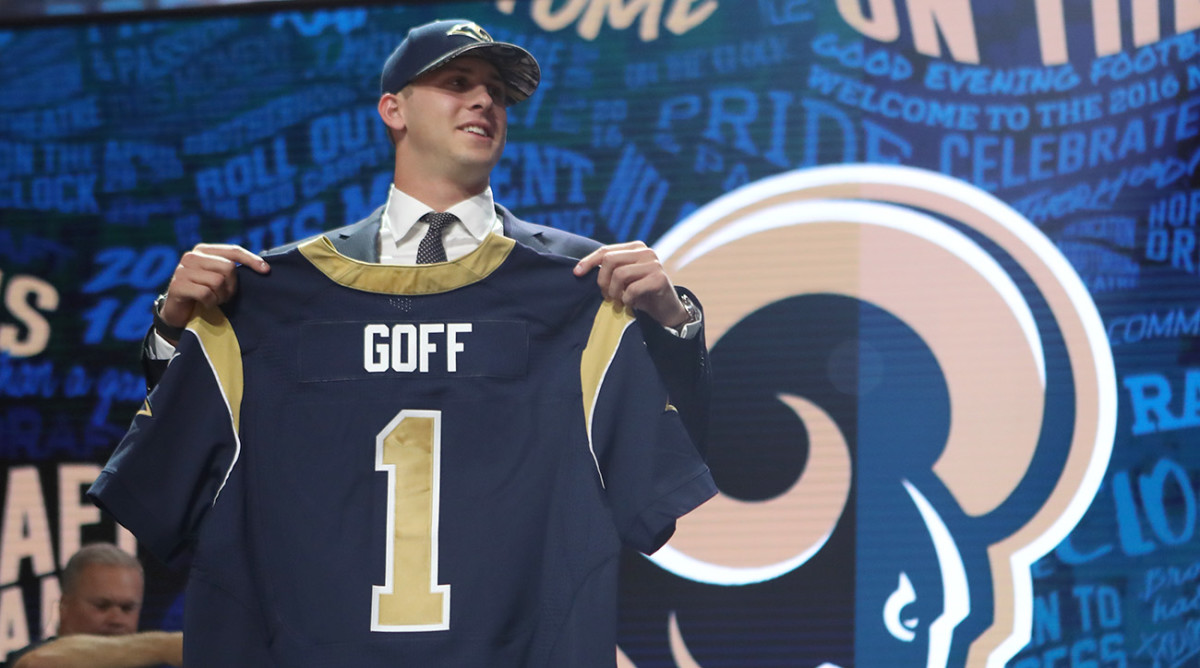Goff, Wentz, and How Young QBs Thrive

Seven times in NFL history, quarterbacks have been taken 1 and 2 in the draft. The first five times, at least one team wound up disappointed, while the sixth time (Jameis Winston and Marcus Mariota) brought two quality starters with a chance to develop into something more. The seventh time, the two franchises appear to have struck gold.
Time will tell whether or not they sustain this success, but when Jared Goff and Carson Wentz take the field at the L.A. Coliseum this Sunday, the 2016 No. 1 pick, Goff, will have passer rating of 98.4 on the season. The No. 2 pick, Wentz, will have a rating of 102.0. Their offenses will enter as the only ones averaging over 30 points per game, and their teams will be a combined 19-5, with front-runner positioning for an NFC playoff bye week on the line.
How did we get here? And how did we arrive so soon? Before exploring that, let’s understand one thing: This is not a debate about who is better between Goff or Wentz. Because there is no debate. It’s Wentz. He and Goff may have entered the league in the same class of QBs, but the class Wentz resides in now includes the likes of Brady, Rodgers, Ryan and Brees. Goff, on the other hand, is still roaming the halls, searching for a room, bumping into QBs like Derek Carr and Jameis Winston along the way.

Wentz is a superstar because he has what Andrew Luck has always had: an uncanny ability to extend a play without breaking it down. Wentz is mobile enough to consistently escape defenders, and yet whenever possible he stays in the pocket and relies on his arm (which packs more than enough strength). He’s a first-class playmaker who quarterbacks with discipline.
That discipline has propagated an expansive offense in Philadelphia. Even though Wentz played collegiately at the FCS level, the system he ran at North Dakota State made him the most pro-ready QB to enter the league since Luck in 2012. Still, in 2016, then-first-year head coach Doug Pederson brought his first-year QB along slowly. Pederson featured widened formations and a ton of three-step timing throws, keeping Wentz’s reads inherently simple.
The plan was to gradually push Wentz into a more complex system after Year One. Even though Wentz’s rookie season was marred by a mid-season slump featuring mechanical glitches and poor decisions, the Eagles went through with said plan. When your quarterback can extend plays as remarkably as Wentz, you run an aggressive, downfield-attacking offense. So, over the offseason, as Wentz honed his mechanics, Philadelphia signed a wide receiver who can run by people (Torrey Smith), and one who can reach over them (Alshon Jeffery). Both brought a vertical dimension to the passing attack, plus their arrival pushed third-year pro Nelson Agholor into the slot, where he has struck oil.
The instant the 2017 season got underway, it was clear the Eagles would follow through wholeheartedly with the plan. Their first few series in Week 1 against Washington featured a variety of play-action deep shots. As the season has progressed, the aerial attack has grown to feature a litany of five-and seven-step timing dropbacks. Pederson has done a masterful job out-leveraging defenses with two-and three-man route combinations. Wentz now has a full field to exploit vertically and horizontally, and he has responded by making sharp reads on a regular basis.
It helps that the Eagles have an extensive ground game. We saw glimmers of this last season. Now, with the trade for Jay Ajayi, there are two power backs (LeGarrette Blount is the other) to feature in multi-tight end sets, plus shiftier backs like Corey Clement and Kenjon Barner, who can run out of three-receiver sets. None are super dynamic, but all are steady behind Philly’s stalwart O-line and in the league’s most diverse running scheme. Each week from the Eagles, you see inside and outside zone, gap scheme runs like “power” and “counter,” trap plays and selective snaps of read-option. It’s an inherently balanced offense. When the ground game doesn’t work (and in every NFL game, there will be two-play sequences where it doesn’t), Wentz’s playmaking prowess can provide answers on third-and-long. When the ground game does work, it helps create opportunities for first- and second-down passing, which is where chunk yardage comes.

He’s done very well on third down, but first and second down is where he cashes his checks, and it’s why Los Angeles joins Philadelphia in the 30 Points Per Game Club. If play-action is a pillar in Philly’s offense, it’s the foundation of the Rams’. Head coach Sean McVay features condensed formations, with receivers in tight splits where they have quick access to the middle of the field on bang-bang play-action timing, as well as space to attack outside, allowing for the designed rollouts that the surprisingly spry Goff is getting better at executing.
Play-action simplifies things by creating half-field and either-or reads for a QB. It also counters the pass rush, which alleviates some of the concern about Goff’s efficacy at throwing with defenders around him. Goff has exhibited the necessary toughness—he’s not afraid to get hit—but he still sometimes instinctively moves before he needs to. That can grossly hinder a QB’s growth (see Blaine Gabbert, who is what a failed Goff might look like).
Goff, to his credit, is getting better at operating with bodies around him. It helps that McVay’s play designs work to Goff’s strengths. In many respects, Goff is a more talented version of the QB McVay had in Washington, Kirk Cousins. Goff is a little stronger-armed and maybe a touch more athletic, but like Cousins, he is a timing and rhythm thrower. He’s proficient on seam balls and when targeting receivers running patterns in a multi-route combination. And encouragingly, the more critical the situation, the more assertively Goff plays.
What’s also starting to show is Goff’s comfort at finding his checkdown. This is one of the overlooked traits that makes guys like Tom Brady and Philip Rivers wildly productive year after year. Checkdowns create hidden yardage, including by just keeping an offense out of negative plays. Goff is getting better by the week at checking it down at the right time, and the Rams have an excellent post-catch running threat in Todd Gurley, who has also become a major component in the regular aerial attack. Involving Gurley, whether on screens or designer vertical routes from the backfield, is another way to define the throw for Goff.
Jim Schwartz Has Turned Around the Eagles Defense, and He Isn’t Thinking About His Next Job
Of course, on paper, almost every play design works. The difference with Wentz in Philly’s offense and Goff in Los Angeles’s is in the people. Both offenses are run by a young but responsible QB, and that QB is surrounded by quality coaches. Pederson and Eagles offensive coordinator Frank Reich were both backups behind legendary QBs (Pederson for Brett Favre, Reich for Jim Kelly). They came up through the coaching ranks under esteemed veteran offensive minds like Andy Reid (Pederson) and longtime Colts offensive coordinator Tom Moore (Reich). The man who works with Wentz most directly, quarterbacks coach John DeFilippo, was probably the most sought-after would-be offensive coordinator this past offseason. (The Eagles wouldn’t let him interview.) For Goff, there’s McVay, who might already be the best offensive mind in football, plus offensive coordinator Matt LaFleur, a Kyle Shanahan disciple who was the position coach for MVP Matt Ryan for two years. There’s also QB coach Greg Olson, who has coordinated offenses for five different teams in 10 different seasons during his 16-year NFL career.
Both the Eagles and Rams franchises are in near-perfect conditions now and for the future. Other teams should pay close attention, because these conditions were not inherited, they were created.
• Question or comment? Email us at talkback@themmqb.com.
